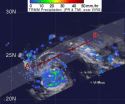(Press-News.org) LA JOLLA, CA -- A "hidden" code linked to the DNA of plants allows them to develop and pass down new biological traits far more rapidly than previously thought, according to the findings of a groundbreaking study by researchers at the Salk Institute for Biological Studies.
The study, published today in the journal Science, provides the first evidence that an organism's "epigenetic" code - an extra layer of biochemical instructions in DNA - can evolve more quickly than the genetic code and can strongly influence biological traits.
While the study was limited to a single plant species called Arabidopsis thaliana, the equivalent of the laboratory rat of the plant world, the findings hint that the traits of other organisms, including humans, might also be dramatically influenced by biological mechanisms that scientists are just beginning to understand.
"Our study shows that it's not all in the genes," said Joseph Ecker, a professor in Salk's Plant Molecular and Cellular Biology Laboratory, who led the research team. "We found that these plants have an epigenetic code that's more flexible and influential than we imagined. There is clearly a component of heritability that we don't fully understand. It's possible that we humans have a similarly active epigenetic mechanism that controls our biological characteristics and gets passed down to our children. "
With the advent of techniques for rapidly mapping the DNA of organisms, scientists have found that the genes stored in the four-letter DNA code don't always determine how an organism develops and responds to its environment. The more biologists map the genomes of various organisms (their entire genetic code), the more they are discovering discrepancies between what the genetic code dictates and how organisms actually look and function.
In fact, many of the major discoveries that led to these conclusions were based upon studies in plants. There are traits such as flower shape and fruit pigmentation in some plants that are under the control of this epigenetic code. Such traits, which defy the predictions of classical Mendelian genetics, are also found in mammals. In some strains of mice, for instance, a tendency for obesity can pass from generation to generation, but no difference between the genetic code of fat mice and thin mice explains this weight difference.
Scientists have even found that identical human twins exhibit different biological traits, despite their matching DNA sequences. They have theorized that such unexplained disparities could be the work of epigenetic variation.
"Since none of these patterns of variation and inheritance match what the genetic sequence says should happen, there is a clearly a component of the 'genetic' heritability that is missing," Ecker said.
Ecker and other scientists have traced these mysterious patterns to chemical markers that serve as a layer of genetic control on top of the DNA sequence. Just as genetic mutations can arise spontaneously and be inherited by subsequent generations, epigenetic mutations can emerge in individuals and spread into the broader population.
Although scientists have identified a number of epigenetic traits, very little was known about how often they arose spontaneously, how quickly they could spread through a population and how significant an influence they could have on biological development and function.
"Perception of the extent of epigenetic variation in plants from generation to generation varies widely within our scientific community," said Robert Schmitz, a post-doctoral research in Eckers' laboratory and the lead author on the paper. "We actually did the experiment, and found that overall there is very little change between each generation, but spontaneous epimutations do exist in populations and arise at a rate much higher than the DNA mutation rate, and at times they had a powerful influence over how certain genes were expressed."
In their study, the Salk researchers and collaborators at Scripps Research Institute mapped the epigenome of a population of Arabidopsis plants then observed how this biochemical landscape had changed after 30 generations. This mapping consisted of recording the state of all locations on the DNA molecule that could undergo a chemical modification known as methylation, a key epigenetic change that can alter how certain underlying genes are expressed. They then watched how methylation states of these sites evolved over the generations.
The plants were all clones of a single ancestor, so their DNA sequences were essentially identical across the generations. Thus any changes in how the plants expressed certain genetic traits were likely to be a result of spontaneous changes in their epigenetic code - variations in the methylation of the DNA sites- not the result of variations in the underlying DNA sequences.
"You couldn't do this kind of study in humans, because our DNA gets shuffled each generation," Ecker said. "Unlike people, some plants are easily cloned, so we can see the epigenetic signature without all the genetic noise."
The researchers discovered that as many as a few thousand methylation sites on the plants' DNA were altered each generation. Although this represents a small proportion of the potentially six million methylation sites estimated to exist on Arabidopsis DNA, it dwarfs the rate of spontaneous change seen at the DNA sequence level by about five orders of magnitude.
This suggests that the epigenetic code of plants - and other organisms, by extension - is far more fluid than their genetic code.
Even more surprising was the extent to which some of these changes turned genes on or off. A number of plant genes that underwent heritable changes in methylation also experienced substantial alterations in their expression - the process by which genes control cellular function through protein production.
This meant that not only was the epigenome of the plants morphing rapidly despite the absence of any strong environmental pressure, but that these changes could have a powerful influence on the plants' form and function.
Ecker said the results of the study provide some of the first evidence that the epigenetic code can be rewritten quickly and to dramatic effect. "This means that genes are not destiny," he said. "If we are anything like these plants, our epigenome may also undergo relatively rapid spontaneous change that could have a powerful influence on our biological traits."
Now that they have shown the extent to which spontaneous epigenetic mutations occur, the Salk researchers plan to unravel the biochemical mechanisms that allow these changes to arise and get passed from one generation to the next.
They also hope to explore how different environmental conditions, such as differences in temperature, might drive epigenetic change in the plants, or, conversely, whether epigenetic traits provide the plants with more flexibility in coping with environmental change.
"We think these epigenetic events might silence genes when they aren't needed, then turned them back on when external conditions warrant," Ecker said. "We won't know how important these epimutations are until we measure the effect on plant traits, and we're just now to the point where we can do these experiments. It's very exciting."
INFORMATION:
The research is supported by the National Science Foundation, the National Institutes of Health, the Howard Hughes Medical Institute, the Gordon and Betty Moore foundation and the Mary K. Chapman Foundation.
Are genes our destiny?
Salk scientists discover 'hidden' code in DNA evolves more rapidly than genetic code
2011-09-19
ELSE PRESS RELEASES FROM THIS DATE:
Scab resistance in durum wheat
2011-09-19
MADISON, WI, SEPTEMBER 16, 2011 -- Durum wheat is a valuable cereal crop widely used for human consumption in the United States, Canada, and several European countries. Scab or Fusarium head blight is one of the crop's most serious diseases, reducing its grain yield and quality. Current durum cultivars don't have resistance to this widespread disease.
While working on the Durum Germplasm Enhancement Project (DGE), Dr. Prem Jauhar and staff at the USDA-ARS Northern Crop Research Laboratory, Fargo, ND discovered that a diploid wheatgrass contains the genes needed for scab ...
Balloon-based experiment to measure gamma rays 6,500 light years distant
2011-09-19
DURHAM, N.H. – Beginning Sunday, September 18, 2011 at NASA's launch facility in Fort Sumner, New Mexico, space scientists from the University of New Hampshire will attempt to send a balloon up to 130,000 feet with a one-ton instrument payload to measure gamma rays from the Crab Pulsar, the remains of a supernova explosion that lies 6,500 light years from Earth. The launch is highly dependent on weather and wind conditions, and the launch window closes at the end of next week.
The Gamma Ray Polarimeter Experiment (GRAPE), which was designed and built at the Space Science ...
Breeding soybeans for improved feed
2011-09-19
MADISON, WI, SEPTMEBER 12, 2011 -- Modifying soybean seed to increase phosphorus content can improve animal nutrition and reduce feed costs and nutrient pollution. However, further research is needed to commercialize this valuable technology. Knowledge of soybean and other crops such as maize suggest that reducing phytate, the principle storage form of phosphorus in plant tissue, in seeds reduces seed germination and emergence of seedlings in the field. In soybean, however, researchers debate whether this problem exists, and suggest that other factors may be the cause.
New ...
Lasers could be used to detect roadside bombs
2011-09-19
EAST LANSING, Mich. — A research team at Michigan State University has developed a laser that could detect roadside bombs – the deadliest enemy weapon encountered in Iraq and Afghanistan.
The laser, which has comparable output to a simple presentation pointer, potentially has the sensitivity and selectivity to canvas large areas and detect improvised explosive devices – weapons that account for around 60 percent of coalition soldiers' deaths. Marcos Dantus, chemistry professor and founder of BioPhotonic Solutions, led the team and has published the results in the current ...
NASA sees power within hurricane Maria as it heads for a landfall in Newfoundland
2011-09-19
VIDEO:
This animation of NOAA's GOES-13 satellite observations from Sept. 6 at 8:45 a.m. EDT through Sept. 16 at 7:45 a.m. EDT shows the movement of Hurricane Katia followed by Tropical...
Click here for more information.
Hurricane Maria joins twelve other hurricanes on record to make landfall in Newfoundland, Canada, and NASA satellite imagery revealed its inner strength.
The Tropical Rainfall Measuring Mission (TRMM) satellite passed over Hurricane Maria on Sept. ...
NASA's TRMM satellite sees moderate rainfall Tropical Storm Sonca
2011-09-19
When the Tropical Rainfall Measuring Mission (TRMM) satellite flew over Tropical Storm Sonca on Friday, Sept. 16 it found moderate rainfall mostly on the southern side of the storm. Chichi Jima can expect some of that rainfall over the weekend as Sonca passes east of the island.
TRMM passed over Tropical Storm Sonca and its precipitation radar instrument saw moderate rainfall occurring mostly on the southern side of the storm, while light-to-moderate rainfall was occurring throughout the storm. The southern edge of the storm had rainfall rates between .78 to 1.57 inches ...
Infrared satellite data shows Tropical Storm Roke strengthening
2011-09-19
Tropical Storm Roke has changed in size and is starting to change in strength. Roke appears to be consolidating in infrared imagery from NASA's Aqua satellite.
Roke began its life as a monsoon depression with a large low-level circulation center that over time consolidated and organized. The eastern half of Tropical Storm Roke was seen in an infrared image from NASA's Aqua satellite AIRS (Atmospheric Infrared Sounder) on Sept. 15, and it showed a more consolidated center with strong convection and very cold cloud-top temperatures.
Cloud-top temperatures are important ...
Study suggests possible link between two Type 2 diabetes drugs and pancreatic cancer
2011-09-19
Two newer drugs used to treat Type 2 diabetes could be linked to a significantly increased risk of developing pancreatitis and pancreatic cancer, and one could also be linked to an increased risk of thyroid cancer, according to a new UCLA study.
Researchers from the Larry L. Hillblom Islet Research Center at UCLA examined the U.S. Food and Drug Administration's database for adverse events reported between 2004 and 2009 among patients using the drugs sitagliptin and exenatide. They found a six-fold increase in the odds ratio for reported cases of pancreatitis with these ...
People born after World War II are more likely to binge drink and develop alcohol disorders
2011-09-19
September 15, 2011 --. In a review of 31 peer-reviewed and published studies, researchers at Columbia University's Mailman School of Public Health looked generational and gender differences in alcohol consumption, alcohol disorders, and mortality. Findings indicate that people born after World War II are more likely to binge drink and develop alcohol use disorders. Researchers also found that the gender gap in alcoholism and problem drinking is narrowing in many countries.
Findings will be published in the December 2011 issue of Alcoholism: Clinical & Experimental Research ...
Autism, intellectual disabilities related to parental age, education and ethnicity, not income
2011-09-19
SALT LAKE CITY – New research from the University of Utah in collaboration with the Utah Department of Health (UDOH) shows that the presence or absence of intellectual disability (ID) and autism spectrum disorders (ASD) varies with risk factors such as gender, parental age, maternal ethnicity, and maternal level of education. The study, published Sept. 15, 2011, in Autism Research, also shows that household income level has no association with either ID or ASD, in contrast to what other studies have suggested.
ASDs are a group of childhood neurodevelopmental disorders ...
LAST 30 PRESS RELEASES:
Making lighter work of calculating fluid and heat flow
Normalizing blood sugar can halve heart attack risk
Lowering blood sugar cuts heart attack risk in people with prediabetes
Study links genetic variants to risk of blinding eye disease in premature infants
Non-opioid ‘pain sponge’ therapy halts cartilage degeneration and relieves chronic pain
AI can pick up cultural values by mimicking how kids learn
China’s ecological redlines offer fast track to 30 x 30 global conservation goal
Invisible indoor threats: emerging household contaminants and their growing risks to human health
Adding antibody treatment to chemo boosts outcomes for children with rare cancer
Germline pathogenic variants among women without a history of breast cancer
Tanning beds triple melanoma risk, potentially causing broad DNA damage
Unique bond identified as key to viral infection speed
Indoor tanning makes youthful skin much older on a genetic level
Mouse model sheds new light on the causes and potential solutions to human GI problems linked to muscular dystrophy
The Journal of Nuclear Medicine ahead-of-print tip sheet: December 12, 2025
Smarter tools for peering into the microscopic world
Applications open for funding to conduct research in the Kinsey Institute archives
Global measure underestimates the severity of food insecurity
Child survivors of critical illness are missing out on timely follow up care
Risk-based vs annual breast cancer screening / the WISDOM randomized clinical trial
University of Toronto launches Electric Vehicle Innovation Ontario to accelerate advanced EV technologies and build Canada’s innovation advantage
Early relapse predicts poor outcomes in aggressive blood cancer
American College of Lifestyle Medicine applauds two CMS models aligned with lifestyle medicine practice and reimbursement
Clinical trial finds cannabis use not a barrier to quitting nicotine vaping
Supplemental nutrition assistance program policies and food insecurity
Switching immune cells to “night mode” could limit damage after a heart attack, study suggests
URI-based Global RIghts Project report spotlights continued troubling trends in worldwide inhumane treatment
Neutrophils are less aggressive at night, explaining why nighttime heart attacks cause less damage than daytime events
Menopausal hormone therapy may not pose breast cancer risk for women with BRCA mutations
Mobile health tool may improve quality of life for adolescent and young adult breast cancer survivors
[Press-News.org] Are genes our destiny?Salk scientists discover 'hidden' code in DNA evolves more rapidly than genetic code



